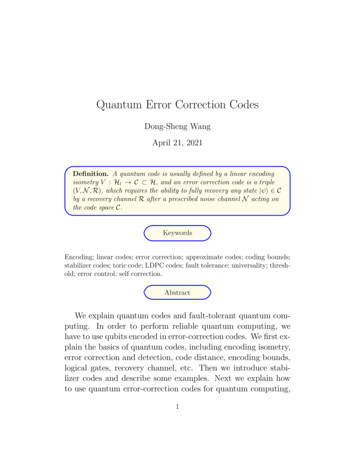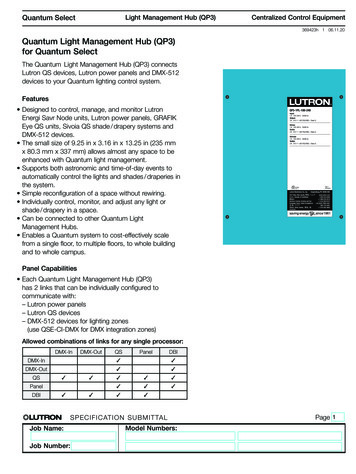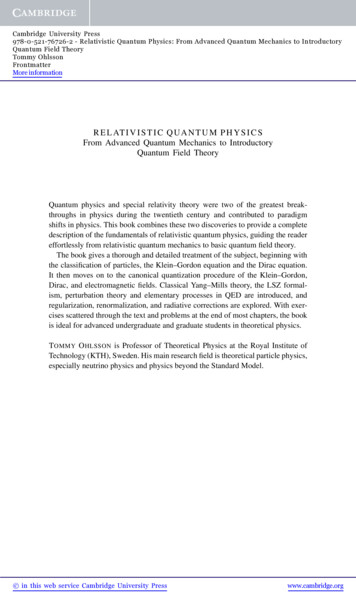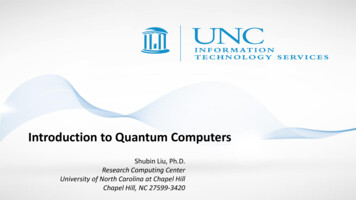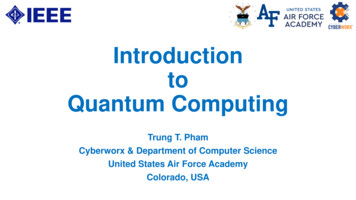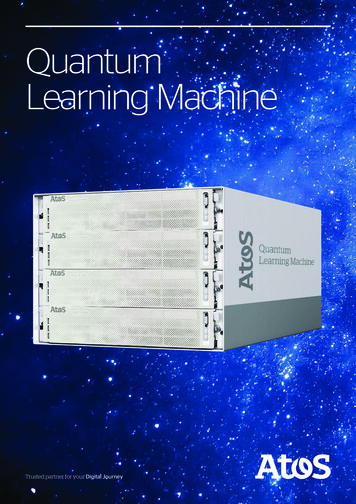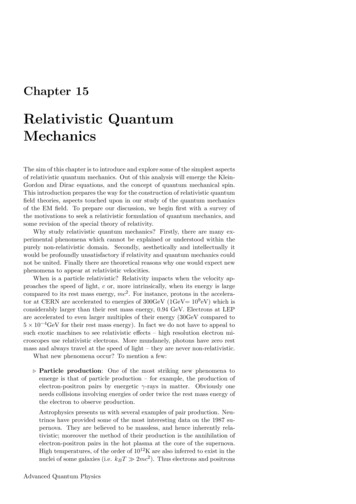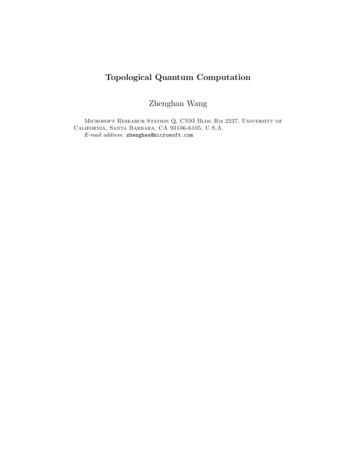
Transcription
Topological Quantum ComputationZhenghan WangMicrosoft Research Station Q, CNSI Bldg Rm 2237, University ofCalifornia, Santa Barbara, CA 93106-6105, U.S.A.E-mail address: zhenghwa@microsoft.com
2010 Mathematics Subject Classification. Primary 57-02, 18-02; Secondary 68-02,81-02Key words and phrases. Temperley-Lieb category, Jones polynomial, quantumcircuit model, modular tensor category, topological quantum field theory,fractional quantum Hall effect, anyonic system, topological phases of matter
To my parents, who gave me life.To my teachers, who changed my life.To my family and Station Q, where I belong.
ContentsPrefacexiAcknowledgmentsxvChapter 1. Temperley-Lieb-Jones Theories1.1. Generic Temperley-Lieb-Jones algebroids1.2. Jones algebroids1.3. Yang-Lee theory1.4. Unitarity1.5. Ising and Fibonacci theory1.6. Yamada and chromatic polynomials1.7. Yang-Baxter equation11131617192222Chapter 2. Quantum Circuit Model2.1. Quantum framework2.2. Qubits2.3. n-qubits and computing problems2.4. Universal gate set2.5. Quantum circuit model2.6. Simulating quantum physics25262729293132Chapter 3. Approximation of the Jones Polynomial3.1. Jones evaluation as a computing problem3.2. FP#P -completeness of Jones evaluation3.3. Quantum approximation3.4. Distribution of Jones evaluations3535363739Chapter 4. Ribbon Fusion Categories4.1. Fusion rules and fusion categories4.2. Graphical calculus of RFCs4.3. Unitary fusion categories4.4. Link and 3-manifold invariants4.5. Frobenius-Schur indicators4.6. Modular tensor categories4.7. Classification of MTCs4141444849515355Chapter 5. (2 1)-TQFTs5.1. Quantum field theory5.2. Witten-Chern-Simons theories5.3. Framing anomaly5.4. Axioms for TQFTs5758606161vii
viiiCONTENTS5.5.5.6.5.7.5.8.5.9.Jones-Kauffman TQFTsDiagram TQFTsReshetikhin-Turaev TQFTsTuraev-Viro TQFTsFrom MTCs to TQFTs6769717172Chapter 6. TQFTs in Nature6.1. Emergence and anyons6.2. FQHE and Chern-Simons theory6.3. Algebraic theory of anyons6.4. Intrinsic entanglement7373757886Chapter 7. Topological Quantum Computers7.1. Anyonic quantum computers7.2. Ising quantum computer7.3. Fibonacci quantum computer7.4. Universality of anyonic quantum computers7.5. Topological quantum compiling7.6. Approximation of quantum invariants7.7. Adaptive and measurement-only TQC8989919293949495Chapter 8. Topological phases of matter8.1. Doubled quantum liquids8.2. Chiral quantum liquids8.3. CFT and holo mono8.4. Bulk–edge correspondence8.5. Interacting anyons and topological symmetry8.6. Topological phase transition8.7. Fault tolerance9797102104105105106106Chapter 9. Outlook and Open Problems9.1. Physics9.2. Computer science9.3. Mathematics109109110110Bibliography111
CONTENTSxix
PrefaceThe factors of any integer can be found quickly by a quantum computer. SinceP. Shor discovered this efficient quantum factoring algorithm in 1994 [S], peoplehave started to work on building these new machines. As one of those people, Ijoined Microsoft Station Q in Santa Barbara to pursue a topological approach in2005. My dream is to braid non-abelian anyons. So long hours are spent picturingquasiparticles in fractional quantum Hall liquids. From my UCSB office, I oftensee small sailboats on the Pacific. Many times I am lost in thought imagining thatthey are anyons and the ocean is an electron liquid. Then to carry out a topologicalquantum computation is as much fun as jumping into such small sailboats andsteering them around each other.Will we benefit from such man-made quantum systems besides knowing factorsof large integers? A compelling reason comes from R. Feynman: a quantum computer is an efficient universal simulator of quantum mechanics [Fe82]. Later, anefficient simulation of topological quantum field theories was given by M. Freedman,A. Kitaev, and the author [FKW]. These results support the idea that quantumcomputers can efficiently simulate quantum field theories, though rigorous resultsdepend on mathematical formulations of quantum field theories. So quantum computing literally promises us a new world. More speculatively, while the telescopeand microscope have greatly extended the reach of our eyes, quantum computerswould enhance the power of our brains to perceive the quantum world. Would itthen be too bold to speculate that useful quantum computers, if built, would playan essential role in the ontology of quantum reality?Topological quantum computation is a paradigm to build a large scale quantumcomputer based on topological phases of matter. In this approach, information isstored in the lowest energy states of many-anyon systems and processed by braidingnon-abelian anyons. The computational answer is accessed by bringing anyons together and observing the result. Topological quantum computation stands uniquelyat the interface of quantum topology, quantum physics, and quantum computing,enriching all three subjects with new problems. The inspiration comes from twoseemingly independent themes which appeared around 1997. One was Kitaev’s ideaof fault-tolerant quantum computation by anyons [Ki1], and the other was Freedman’s program to understand the computational power of topological quantum fieldtheories [Fr1]. It turns out that these ideas are two sides of the same coin: thealgebraic theory of anyons and the algebraic data of a topological quantum fieldtheory are both modular tensor categories. The synthesis of the two ideas usheredin topological quantum computation. The topological quantum computation modelis efficiently equivalent to other models of quantum computation such as the quantum circuit model in the sense that all models solve the same class of problems inpolynomial time [FKLW].xi
xiiPREFACEBesides its theoretical esthetic appeal, the practical merit of the topologicalapproach lies in its error-minimizing hypothetical hardware: topological phases ofmatter are fault-avoiding or deaf to most local noises. There exist semi-realisticlocal model Hamiltonians whose ground states are proven to be error-correctioncodes such as the celebrated toric code. It is an interesting question to understand if fault-avoidance will survive in more realistic situations, such as at finitetemperatures or with thermal fluctuations. Perhaps no amount of modeling canbe adequate for us to understand completely Mother Nature, who has repeatedlysurprised us with her magic.We do not have any topological qubits yet. Since scalability is not really an issuein topological quantum computation—rather, the issue is controlling more anyons inthe system—it follows that demonstrating a single topological qubit is very close tobuilding a topological quantum computer. The most advanced experimental effortto build a topological quantum computer at this writing is fractional quantum Hallquantum computation. There is both experimental and numerical evidence thatnon-abelian anyons exist in certain 2-dimensional electron systems that exhibitthe fractional quantum Hall effect. Other experimental realizations are conceivedin systems such as rotating bosons, Josephson junction arrays, and topologicalinsulators.This book expands the plan of the author’s 2008 NSF-CBMS lectures on knotsand topological quantum computing, and is intended as a primer for mathematicallyinclined graduate students. With an emphasis on introduction to basic notions andcurrent research, the book is almost entirely about the mathematics of topologicalquantum computation. For readers interested in the physics of topological quantumcomputation with an emphasis on fractional quantum Hall quantum computing,we recommend the survey article [NSSFD]. The online notes of J. Preskill [P]and A. Kitaev’s two seminal papers [Ki1, Ki2] are good references for physicallyinclined readers. The book of F. Wilczek [Wi2] is a standard reference for thephysical theory of anyons, and contains a collection of reprints of classical paperson the subject.The CBMS conference gave me an opportunity to select a few topics for acoherent account of the field. No efforts have been made to be exhaustive. Theselection of topics is personal, based on my competence. I have tried to cite theoriginal reference for each theorem along with references which naturally extend theexposition. However, the wide-ranging and expository nature of this monographmakes this task very difficult if not impossible. I apologize for any omission in thereferences.The contents of the book are as follows: Chapters 1,2,4,5,6 are expositions, insome detail, of Temperley-Lieb-Jones theory, the quantum circuit model, ribbonfusion category theory, topological quantum field theory, and anyon theory, whileChapters 3,7,8 are sketches of the main results on selected topics. Chapter 3 is onthe additive approximation of the Jones polynomial, Chapter 7 is on the universality of certain anyonic quantum computers, and Chapter 8 is on mathematicalmodels of topological phases of matter. Finally, Chapter 9 lists a few open problems. Chapters 1,2,3 give a self-contained treatment of the additive approximationalgorithm. Moreover, universal topological quantum computation models can bebuilt from some even half theories of Jones algebroids such as the Fibonacci theory
PREFACExiii[FLW1]. Combining the results together, we obtain an equivalence of the topological quantum computation model with the quantum circuit model. Chapters 1,2,3,based on graphical calculus of ribbon fusion categories, are accessible to entry-levelgraduate students in mathematics, physics, or computer science. A ribbon fusioncategory, defined with 6j symbols, is up to equivalence just some point on a realalgebraic variety of polynomial equations. Therefore the algebraic theory of anyonsis elementary, given basic knowledge of surfaces and their mapping class groups ofinvertible self transformations up to deformation.Some useful books on related topics are: for mathematics, Bakalov-Kirillov [BK], Kassel [Kas], Kauffman-Lins [KL], and Turaev [Tu]; for quantum computation, Kitaev-Shen-Vyalyi [KSV] and Nielsen-Chuang [NC]; and for physics,Altland-Simons [AS], Di Francesco-Mathieu-Senechal [DMS], and Wen [Wen7].Topological quantum computation sits at the triple juncture of quantum topology, quantum physics, and quantum computation:QTQPTQCQCThe existence of topological phases of matter with non-abelian anyons would leadus to topological quantum computation via unitary modular tensor categories./ UMTC/ TQCTPMTherefore the practical aspect of topological quantum computation hinges on theexistence of non-abelian topological states.Will we succeed in building a large-scale quantum computer? Only time willtell. To build a useful quantum computer requires unprecedented precise control ofquantum systems, and complicated dialogues between the classical and quantumworlds. Though Nature seems to favor simplicity, she is also fond of complexity asevidenced by our own existence. Therefore there is no reason to believe that shewould not want to claim quantum computers as her own.Zhenghan WangStation Q, Santa Barbara
AcknowledgmentsI would like to thank CBMS and NSF for sponsoring the conference; C. Simmons and J. Byrne for the excellent organization; and A. Basmajian, W. Jaco,E. Rowell, and S. Simon for giving invited lectures. It was a pleasure to lectureon an emerging field that is interdisciplinary and still rapidly developing. Overthe years I have had the good fortune to work with many collaborators in mathematics and physics, including M. Freedman, A. Kitaev, M. Larsen, A. Ludwig,C. Nayak, N. Read, K. Walker, and X.-G. Wen. Their ideas on the subject andother topics strongly influence my thinking, especially M. Freedman. He and I havebeen collaborating ever since I went to UCSD to study under him two decades ago.His influence on me and the field of topological quantum computation cannot beoverstated. I also want to thank M. Fisher. Though not a collaborator, repeatinghis graduate course on condensed matter physics and having many questions answered by him, I started to appreciate the beautiful picture of our world paintedwith quantum field theory, and to gain confidence in physics. He richly deservesof my apple. In the same vein, I would like to thank V. Jones for bringing meto his mathematical world, and his encouragement. Jones’s world is home to me.Last but not least, I would like to thank J. Liptrap for typesetting the book andcorrecting many errors, and D. Sullivan for smoothing the language of the Preface.Of course, errors that remain are mine.xv
CHAPTER 1Temperley-Lieb-Jones TheoriesThis chapter introduces Temperley-Lieb, Temperley-Lieb-Jones, and Jones algebroids through planar diagrams. Temperley-Lieb-Jones (TLJ) algebroids generalize the Jones polynomial of links to colored tangles. Jones algebroids, semisimplequotients of TLJ algebroids at roots of unity, are the prototypical examples of ribbon fusion categories (RFCs) for application to TQC. Some of them are conjecturedto algebraically model anyonic systems in certain fractional quantum Hall (FQH)liquids, with Jones-Wenzl projectors (JWPs) representing anyons. Our diagrammatic treatment exemplifies the graphical calculus for RFCs. Special cases of Jonesalgebroids include the Yang-Lee, Ising, and Fibonacci theories.Diagrammatic techniques were used by R. Penrose to represent angular momentum tensors and popularized by L. Kauffman’s reformulation of the Temperley-Liebalgebras. Recently they have witnessed great success through V. Jones’s planar algebras and K. Walker’s blob homology.1.1. Generic Temperley-Lieb-Jones algebroidsThe goal of this section is to define the generic Jones representations of the braidgroups by showing that the generic Temperley-Lieb (TL) algebras are direct sumsof matrix algebras. Essential for understanding the structure of the TL algebrasare the Markov trace and the Jones-Wenzl idempotents or JWPs. We use themagical properties of the JWPs to decompose TL algebras into matrix algebras.Consequently we obtain explicit formulas for the Jones representations of the braidgroups.1.1.1. Generic Temperley-Lieb algebroids.Definition 1.1. Let F be a field. An F-algebroid Λ is a small F-linear category.Recall that a category Λ is small if its objects, denoted as Λ0 , form a set, ratherthan a class. A category is F-linear if for any x, y P Λ0 the morphism set Hompx, y qis an F-vector space, and for any x, y, z P Λ0 the composition mapHompy, z q Hompx, y q Ñ Hompx, z qis bilinear. We will denote Hompx, y q sometimes as x Λy .The term “F-algebroid” [BHMV] emphasizes the similarity between an Flinear category and an F-algebra. Indeed, we have:Proposition 1.2. Let Λ be an F-algebroid. Then for any x, yF-algebra and x Λy is a y Λy x Λx bimodule.P Λ0 , x Λx is anThe proof is left to the reader, as we will do most of the time in the book. Itfollows that an F-algebroid is a collection of algebras related by bimodules. In the1
21. TEMPERLEY-LIEB-JONES THEORIESfollowing, when F is clear from the context or F C, we will refer to an F-algebroidjust as an algebroid.Let A be an indeterminant over C, and d A2 A 2 . We will call A theKauffman variable, and d the loop variable. Let F CrA, A 1 s be the quotient fieldof the ring of polynomials in A. Let I r0, 1s be the unit interval, and R I Ibe the square in the plane. The generic Temperley-Lieb (TL) algebroid TLpAq isdefined as follows. An object of TLpAq is the unit interval with a finite set of pointsin the interior of I, allowing the empty set. The object I with no interior points isdenoted as 0. We use x to denote the cardinality of points in x for x P TLpAq0 .Given x, y P TLpAq0 , the set of morphisms Hompx, y q is the following F-vectorspace:If x y is odd, then Hompx, y q is the 0-vector space. If x y is even, firstwe define an px, y q-TL diagram. Identify x with the bottom of R and y with thetop of R. A TL-diagram or just a diagram D is the square R with a collection of x y smooth arcs in the interior of R joining the x y points on the boundary2of R plus any number of smooth simple closed loops in R. All arcs and simpleloops are pairwise non-intersecting, and moreover, all arcs meet the boundary ofR perpendicularly. Note that when x y 0, TL diagrams are just disjointsimple closed loops in R, including the empty diagram. The square with the emptydiagram is denoted by 10 . For examples, see the diagrams below.Two diagrams D1 , D2 are d-isotopic if they induce the same pairing of the x y boundary points (Fig. 1.1). Note that D1 , D2 might have different numbersof simple closed loops. Finally, we define Hompx, y q to be the F-vector space withbasis the set of px, y q-TL diagrams modulo the subspace spanned by all elements ofthe form D1 dm D2 , where D1 is d-isotopic to D2 and m is the number of simpleclosed loops in D1 minus the number in D2 . Note that any diagram D in Homp0, 0qis d-isotopic to the empty diagram. Hence a diagram D with m simple closed loopsas a vector is equal to dm 10 .d-isotopy Figure 1.1. d-isotopic diagrams.Composition of morphisms is given first for diagrams. Suppose D1 , D2 arediagrams in Hompy, z q and Hompx, y q, respectively. The composition of D1 and D2is the diagram D1 D2 in Hompx, z q obtained by stacking D1 on top of D2 , rescalingthe resulting rectangle back to R, and deleting the middle horizontal line (Fig. 1.2). Figure 1.2. Composition of diagrams.Composition preserves d-isotopy, and extends uniquely to a bilinear productHompy, z q Hompx, y q Ñ Hompx, z q.
1.1. GENERIC TEMPERLEY-LIEB-JONES ALGEBROIDS3We are using the so-called optimistic convention for diagrams: diagrams are drawnfrom bottom to top. A general morphism f P Hompx, y q is a linear combination ofTL diagrams. We will call such f a formal diagram.Notice that all objects x of the same cardinality x are isomorphic. We will notspeak of natural numbers as objects in TLpAq because they are used later to denoteobjects in Temperley-Lieb-Jones categories. We will denote the isomorphism classof objects x with x n by 1n . By abuse of notation, 1n will be considered as anobject.1.1.2. Generic TL algebras.Definition 1.3. Given a natural number n P N, the generic TL algebra TLn pAqis just the algebra Homp1n , 1n q in the generic TL algebroid. Obviously TLn pAq isindependent of our choice of the realization of 1n as an object x such that x n.By definition Homp0, 0q F.Definition 1.4. The Markov trace of TLn pAq is an algebra homomorphismTr : TLn pAq Ñ F defined by a tracial closure: choosing n disjoint arcs outside thesquare R connecting the bottom n points with their corresponding top points, for aTL diagram D, after connecting the 2n boundary points with the chosen n arcs anddeleting the boundary of R, we are left with a collection of disjoint simple closedloops in the plane. If there are m of them, we define TrpDq dm (Fig. 1.3). For aformal diagram, we extend the trace linearly.Trpq d Figure 1.3. Markov trace.There is an obvious involution X ÞÑ X on TLn pAq. Given a TL diagram D, letD be the image of D under reflection through the middle line I 12 . Then X ÞÑ Xis extended to all formal diagrams by the automorphism of F which takes A toA 1 and restricts to complex conjugation on C. The Markov trace then induces asesquilinear inner product, called the Markov pairing, on TLn pAq by the formulaxX, Y y TrpXY q for any X, Y P TLn pAq (Fig. 1.4)., d3Figure 1.4. Markov pairing.Define the nth Chebyshev polynomial n pdq inductivelyby 0 1, 1 pdq d, and n 1 pdq d n pdq n 1 pdq. Let cn n 1 1 2nbethe Catalan number.n
41. TEMPERLEY-LIEB-JONES THEORIESThere are cn different TL diagrams tDi u in TLn pAq consisting only of n disjointarcs up to isotopy in R connecting the 2n boundary points of R. These cn diagramsspan TLn pAq as a vector space. Let Mcn cn pmij q be the matrix of the Markovpairing of tDi u in a certain order, i.e. mij TrpDi Dj q. ThenDetpMcn cn q (1.5) n¹ i pdqan,ii 1where an,i 2 . Formula (1.5) is derived in [DGG]. LettUi u, i 1, 2, . . . , n 1, be the TL diagrams in TLn pAq shown in Fig. 1.5.2nn i 22nn i2nn i 1Figure 1.5. Generators of TL.Theorem 1.6. (1) The diagrams tDi u, i 1, 2, . . . , n 1 1 2nn , form a basis of TLn pAq asa vector space, and TLn pAq is generated as an algebra by tUi u, i 0, 1, . . . , n 1.(2) TLn pAq has the following presentation as an abstract algebra with generators tUi uni 01 and relations: dUiUi Ui 1 Ui UiUi Uj Uj Ui if i j 2Generic TLn pAq is a direct sum of matrix algebras over F.Ui2(1.7)(1.8)(1.9)(3)Proof.(1) It suffices to show that every basis diagram Di is a monomial in thegenerators Ui . Fig. 1.6 should convince the reader to construct his/herown proof. The dimension of the underlying vector space of TLn pAq isthe number of isotopic diagrams without loops, which is one of the manyequivalent definitions of the Catalan number. U2 U1Figure 1.6. Decomposition into Ui ’s.(2) By drawing diagrams, we can easily check relations (1.7), (1.8), and (1.9)in TLn pAq. It follows that there is a surjective algebra map φ from TLn pAqonto the abstract algebra with generators tUi u and relations (1.7), (1.8),and (1.9). Injectivity of φ follows from a dimension count: the dimensionsof the underlying vector spaces of both algebras are given by the Catalannumber.
1.1. GENERIC TEMPERLEY-LIEB-JONES ALGEBROIDS5(3) Formula (1.5) can be used to deduce that generic TLn pAq is a semisimplealgebra, hence a direct sum of matrix algebras. An explicit proof is givenin Sec. 1.1.6. The generic TL algebras TLn pAq first appeared in physics, and were rediscovered by V. Jones [Jo3]. Our diagrammatic definition is due to L. Kauffman [Kau].1.1.3. Generic representation of the braid groups. The most importantand interesting representation of the braid group Bn is the Jones representationdiscovered in 1981 [Jo2, Jo4], which led to the Jones polynomial, and the earlierBurau representation, related to the Alexander polynomial.The approach pioneered by Jones is to study finite-dimensional quotients of thegroup algebra Fr Bn s, which are infinite-dimensional representations of the braidgroup: b P Bn , bp ci gi q ci pbgi q. If a finite-dimensional quotient is given by analgebra homomorphism, then the regular representation on FrBn s descends to thequotient, yielding a finite-dimensional representation of Bn .TLn pAq is obtained as a quotient of FrBn s by the Kauffman bracket (Fig. 1.7).Figure 1.7. Kauffman bracket.Recall the n-strand braid group Bn has a presentation with generatorstσi i 1, 2, . . . , n 1uand relations σi 1 σi σi 1 .The Kauffman bracket induces a map x, y : FrBn s Ñ TLn pAq by the formula xσi y A id A 1 Ui .Proposition 1.10. The Kauffman bracket x, y : FrBn s Ñ TLn pAq is a surjecσi σj σj σiif i j 2,σi σi1 σitive algebra homomorphism.The proof is a straightforward computation.Definition 1.11. Since generic TLn pAq is isomorphic to a direct sum of matrixalgebras over F, the Kauffman bracket x, y maps Bn to non-singular matrices overF, yielding a representation ρA of Bn called the generic Jones representation.It is a difficult open question to determine whether ρA sends nontrivial braidsto the identity matrix, i.e., whether the Jones representation is faithful. Next wewill use Jones-Wenzl projectors to describe the Jones representation explicitly.1.1.4. Jones-Wenzl projectors. In this section we show the existence anduniqueness of the Jones-Wenzl projectors.Theorem 1.12. Generic TLn pAq contains a unique pn characterized by:pn 0.p2n pn .
61. TEMPERLEY-LIEB-JONES THEORIES pn Ui 0 for all 1 i n 1. Furthermore pn can be written as pn 1 U , where U cj mj , where mjnontrivial monomials of Ui ’s, 1 i n 1, and cj P F.Ui pnareProof. For uniqueness, suppose pn exists and can be expanded as pn c1 U .Then p2n pn pc1 U q pn pc1q cpn c2 1 cU , so c 1. Let pn 1 U andp1n 1 V , both having the properties above, and expand pn p1n from both sides:p1n 1 p1n p1U qp1n pn p1n pn p1V q pn 1 pn .Existence is completed by an inductive construction of pn 1 from pn , which alsoreveals the exact nature of the “generic” restriction on the loop variable d. Theinduction is as follows, where µn n 1 pdq{ n pdq. p2 p1(1.13)pn1 It is not difficult to check that Ui pnis Un 1 .) d1 pn pn µnpn pn Ui 0, in. (The most interesting case Tracing the inductive definition of pn 1 yields Trpp1 q d and Trppn 1 q Trppn q nn 1 Trppn q, showing that Trppn 1 q satisfies the Chebyshev recursion (andthe initial data). Thus Trppn q n .Jones-Wenzl idempotents were discovered by V. Jones [Jo1], and their inductive construction is due to H. Wenzl [Wenz]. We list the explicit formulas forp2 , p3 , p4 , p5 .p2 2 p3 3 p4 4 d11 d2 d 1d2 1 d2 d 21 d2 2 d2 1 d3 2dd2d4 3d2 2 d3 1 2d d d4 3d2 2d41 3d22
1.1. GENERIC TEMPERLEY-LIEB-JONES ALGEBROIDSp5 5 d47 d2 12 3d 1 d2 1d6 5d4 7d2 2d4 3d2 3d6 5d4 7d2 2 d242d 3d1 d3 dd6 5d4 7d2 2 d3 2d d4 3d2 1 1d4 3d2 1 d3 d d4 3d2 1 d6 5d4 d 7d2 2 d d2642d 5d7d 24d2 d6 5d4d4d 3d2d6 5d4 7d2 2 11 7d2 21.1.5. Trivalent graphs and bases of morphism spaces. To realize eachTL diagram as a matrix, we study representations of TLn pAq Homp1n , 1n q. If y n, then for any object x, Hompx, y q is a representation of TLn pAq by compositionof morphisms: TLn pAq Hompx, y q Ñ Hompx, y q. Therefore we begin with theanalysis of the morphism spaces of the TL algebroid.To analyze these morphism spaces, we introduce colored trivalent graphs torepresent some special basis elements. Let G be a uni-trivalent graph in the squareR, possibly with loops and multi-edges, such that all trivalent vertices are in theinterior of R and all uni-vertices are on the bottom and/or top of R. The univalentvertices together with the bottom or top of R are objects in TLpAq. A coloringof G is an assignment of natural numbers to all edges of G such that edges withuni-vertices are colored by 1. An edge colored by 0 can be dropped, and an edgewithout a color is colored by 1. A coloring is admissible for a trivalent vertex v ofG if the three colors a, b, c incident to v satisfy(1) a b c is even.(2) a b c, b c a, c a b.Let G be a uni-trivalent graph with an admissible coloring whose bottom and topobjects are x, y. Then G represents a formal diagram in Hompx, y q as follows. Spliteach edge of color l into l parallels held together by a Jones-Wenzl projector pl .For each trivalent vertex v with colors a, b, c, admissibility furnishes unique naturalnumbers m, n, p such that a m p, b m n, c n p, allowing us tosmooth v into a formal diagram as in Fig. 1.8. To simplify drawing and notation,p3312 p1Figure 1.8. Trivalent vertex.p2
81. TEMPERLEY-LIEB-JONES THEORIESfor any formal diagram in Hompx, y q, we will not draw the square R with theunderstanding that that the univalent vertices are representing some objects. Alsoa natural number l beside an edge always means the presence of the Jones-Wenzlprojector pl .We will consider many relations among formal diagrams, so we remark thatone relation can lead to many new relations by the following principle.Lemma 1.14 (Principle of annular consequence). Suppose the square R is insidea bigger square S. In the annulus between R and S, suppose there are formaldiagrams connecting objects on R and S. Then any relation r of formal diagramssupported in R induces one supported in S by including the relation r into S, anddeleting the boundary of the old R. The resulting new relation r1 will be called anannular consequence of r (Fig. 1.9). More generally, S can be any compact surface,in which case we will call r1 a generalized annular consequence of r. d d2Figure 1.9. Annular consequence.Proposition 1.15. Let x, y be two objects such that x y 2m. Then(1) dim Hompx, y q m1 1 2mm .(2) Let G be a uni-trivalent tree connecting x and y. Then the collection ofall admissible colorings of G forms a basis of Hompx, y q.Proof.(1) Without loss of generality, we may assume x y . By bending armsdown (Fig. 1.10), we see that Hompx, y q TLm pAq as vector spaces.ÑØFigure 1.10. Bending arms down.(2) Counting admissible colorings of G gives the right dimension. For linear independence, note that the Markov pairing on TLn pAq extends toany Hompx, y q, and is nondegenerate. (This will be easier to see afterSec. 1.1.6.)
1.1. GENERIC TEMPERLEY-LIEB-JONES ALGEBROIDS91.1.6. Generic Temperley-Lieb-Jones categories. Generic TLpAq has atensor product given by horizontal “stacking”: juxtaposition of diagrams. Usingthis tensor product, denoted as b, we see that any object y with y n is isomorphic to a tensor power of an object x with x 1, i.e., 1n 1bn . For ourapplications to TQC, we would like to have xbm “collapsible” to a direct sumof finitely many “simple” objects for all sufficiently large m. To achieve this, weenlarge generic TLpAq to the generic Temperley-Lieb-Jones (TLJ) algebroid, thentake a finite “quotient.” In this section, we describe the generic TLJ categories,which have generic TLpAq as subcategories.Let A be an indeterminant as before. The objects of TLJpAq are objects ofTLpAq with natural number colors: each marked point in I receives a naturalnumber. A point colored by 0 can be deleted. A point without a color is understoodto be colored by 1, hence TLpAq0 TLJpAq0 . Morphisms in Hompx, y q for x, y PTLJpAq0 are formal F-linear combinations of uni-trivalent graphs connecting x, ywith admissible compatible colorings. Again, an edge without a color is colored by1, and an edge of color 0 can be deleted, along with its endpoints. TLJpAq hasa tensor product as in TLpAq: horizontal juxtaposition of formal diagrams. Theempty object is a tensor unit. Every object is self-dual. The involution X ÞÑ X,extended to TLJpAq, is the duality for morphisms.Theorem 1.16. TLJpAq and TLpAq are ribbon
This book expands the plan of the author's 2008 NSF-CBMS lectures on knots and topological quantum computing, and is intended as a primer for mathematically inclined graduate students. With an emphasis on introduction to basic notions and current research, the book is almost entirely about the mathematics of topological quantum computation.

